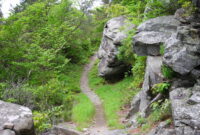Good hiking spots near me: Finding the perfect trail for your next adventure can be exciting, but knowing where to start can be overwhelming. This guide simplifies the process, helping you discover nearby trails that match your preferences, whether you’re a seasoned hiker or a weekend warrior. We’ll explore how to leverage technology and readily available resources to uncover hidden gems and well-loved paths alike, ensuring your next hike is both rewarding and enjoyable.
We’ll cover everything from utilizing location services and user preferences to finding reliable data sources and presenting information in a clear, concise manner. We will also delve into the specifics of filtering, ranking, and displaying hiking spot details, including descriptive text, user reviews, and stunning imagery to help you visualize your next outdoor escape. This guide aims to be your one-stop resource for planning your next hiking adventure.
Handling Errors and Missing Data
Building a robust hiking trail recommendation system requires careful consideration of how to handle situations where data is incomplete or unavailable. Users expect reliable information, and gracefully managing errors is crucial for maintaining a positive user experience. This section details strategies for addressing data gaps and providing informative feedback to users.
Providing informative messages to users when data is missing or a search fails is paramount. Users should never encounter abrupt error messages or unexplained failures. Instead, the system should provide clear, concise, and helpful messages guiding the user towards a resolution or alternative.
Error Handling Strategies
Effective error handling involves a multi-layered approach. First, the system should attempt to retrieve the necessary data from its sources. If the data is unavailable, a default message should be displayed, indicating that information for the specific location is currently unavailable. This message should also suggest alternative actions, such as searching for a nearby location or trying again later. For example, if a user searches for a trail and the database lacks elevation data, the system could display: “Elevation data is currently unavailable for this trail. Please check back later, or explore other nearby trails.” In addition to this, a detailed log should be kept of the error, including the timestamp, user input, and the type of error encountered. This log assists in debugging and identifying patterns in missing data or system failures.
Handling Unexpected Exceptions
Unexpected errors, such as database connection failures or issues with external APIs, require a more robust error-handling mechanism. These exceptions should be caught using appropriate try-except blocks in the code. Instead of displaying raw error messages to the user, a generic error message should be presented, such as: “We are experiencing technical difficulties. Please try again later.” The system should simultaneously log the specific exception details, allowing developers to diagnose and resolve the underlying problem efficiently. This ensures that the user experience remains positive while providing valuable information for developers to improve the system’s reliability.
Data Validation and Default Values
Before processing data, the system should rigorously validate its integrity. This includes checking for missing values, invalid data types, and inconsistencies. Where data is missing, default values can be employed. For instance, if a trail’s difficulty rating is missing, a default value of “Moderate” could be used. However, it’s crucial to clearly communicate to the user that this is a default value and not necessarily accurate. Transparency in data handling builds trust with users. The system could indicate: “Difficulty rating not available; displaying default value of Moderate.”
Last Recap
Ultimately, discovering good hiking spots near you is about more than just finding a trail; it’s about connecting with nature and finding an experience that suits your individual needs and preferences. By utilizing the strategies and resources outlined in this guide, you can confidently embark on your next hiking adventure, fully equipped to find the perfect trail and create unforgettable memories. Remember to always prioritize safety and respect the environment during your explorations.




